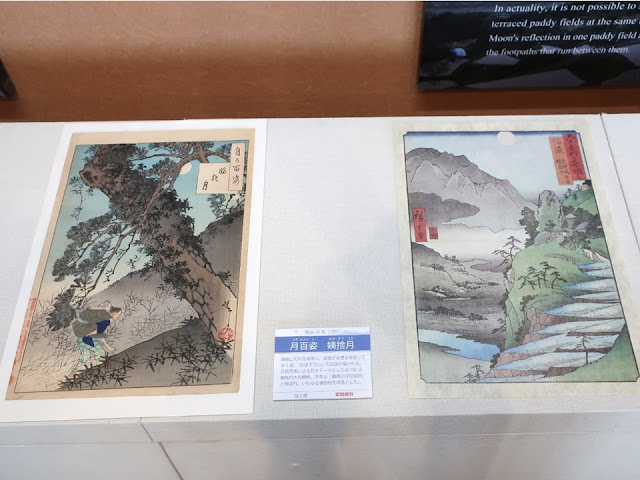The center is located at the tourist spot which is famous for “Tagoto-no-Tsuki” or literally “Moon at each rice field (of terraced paddy fields)”. It's the place where many poets have created poems.
If you walk around there on a moonlit
night, you can see a moon reflected on water of a field. If you proceed, you
can see a moon at the next field. Therefore, the phenomenon is called “Moon at
each rice field”.
センターは見事な棚田に映る月が「田毎の月」と詠まれた名所にあります。姨捨山(冠着山)の麓です。棚田の道を下って行くと、次の田でもその次の田でも水面に月が見え、田毎の月と呼ばれています(すべての田に同時に月が映るわけではありません)。
The stone Buddhist image watches over the terraced rice fields.
広がる棚田を姪石(めいし)が見守っています。
The stone Buddhist image also has watched over the place above called “forty-eight rice fields”.
こちらは48枚田地区。ここでも石仏が棚田を見守っています。
There are nameplates of field tenants who cultivate rice under the support of local farmers. I found several plates of foreigners.
外国人の名札が立った田もあります。「棚田貸します制度」があって、地元農家の支援を受けて耕作しています。
The panel says “a moon viewing event, which has been done since ancient era, shows the sense of beauty of Japanese people" (written in Japanese). The poems about moon viewing there were introduced to nobles in Kyoto (old capital city), that’s why the place was renowned across Japan. The place was on the old highway which run from eastern Japan to Kyoto. Although I could not avoid reflection of glass, I show you some exhibits.
古代からの行われている月見を「日本人の美意識を表す『月見』」と記しています。和歌に詠まれ、都人に伝わり、月の名所になっていきました。姨捨は、京と東日本をつなぐルートにありました。ガラスの写りこみが激しいのですが、いくつかの展示を写真で紹介します。
The local moon festival and groups which worships moon are exhibited.
月に関する祭り、月待ちの講(講の説明/リンク)が紹介されています。
There is a legend about abandoning elderly people to the mountain, which is called “Oba (elderly woman) sute (abandoning) yama(mountain)”. The printing (ukiyoe) on the left (1891) depicts the legend. The printing on the right, which was made in the Edo period (1603~1868), shows “Tagoto-no-Tsuki” (Moon at each rice field of terraced paddy fields).
右側の「六十余州名所図会」(歌川広重)が、姨捨が景勝地であることを紹介しています。左は月岡芳年の姨捨の錦絵(1891)です。
In the Edo period, the grate haiku poem master (Matsuo Basho) visited here and made a poem. Thereafter, many people have visited the site; I’m one of them. When I visited, the moon rose at dawn; I gave up seeing it.
Reference: Basho memorial museum in Tokyo、 芭蕉記念館
江戸時代には、芭蕉の足跡(句は、「おもかげや 姥ひとりなく 月の友」)を慕って、多くの人が訪れました。私もその口です。芭蕉が訪れたのは旧暦の8月15日。満月は見えても稲が伸びた田には月が映っていなかったはずです。田に映る姥はいなかったのでしょうか。私の訪問時は月の出が深夜で、見ることかなわずでした。篠ノ井線の車中からの風景が忘れられなくて訪ねました。
Chorakuji (temple) is a moon viewing spot. Queen Elizabeth II visited the temple (upper right).
月見の名所の長楽寺には、エリザベス女王も訪れました(右上)。
Five lessons to achieve “Choraku” or literally a happy longevity (upper left).
2. A person takes care of others and can thank to them.
3. A person think deeply and write well.
4. A person laughs a lot and does not forget impressions.
5. A person has hobby and like trip.
I like the lessons above.
長楽五カ条、その通りだと思います。
The photo above shows a Noh performance themed the legend about abandoning elderly people. She is the abandoned woman.
謡曲「姨捨」は、都の男たちが中秋の名月を愛でようと来たところ、里の女が「捨てられた老女は私です」と言って、木陰に消え、夜が更けると月光のもとに白衣を着て現れ、月の話を語るというものだそうです。(昭和63年、橋岡久馬師、写真:森田拾史郎、長楽寺の展示品)
I also visited in September. The rice ripened and became golden color.
9月にも訪れました。棚田の稲は実り黄金色になっています。
Harvesting and sun drying began. The sun-dried rice taste good.
刈り入れてはさがけをしています。天日乾燥のお米は美味しいですよね。
Ancient people irrigated and made the terraced fields at the high mountain, so we can see the landscape. We can sympathize with old travelers including poets here. It is no doubt that it is a fun and a feelgood time.
Btw, we can see a moon on water of a field only for several days a year. It is after water is filled to a field, is before rice plants grow, is a moonlight night and is no-wind.
姨捨の棚田は、高所にあるため池と用水路のおかげでできたとのこと。古代から多くの人が歌を詠み謡曲が作られ、外せない観光地になりました。たくさんの粋人が善光寺街道を歩いて訪れたはずですが、①水面に映る月は田に水が張られ、かつ、稲が伸びていない時期で、②月があがる日、③そして風が弱い日にしか見られません。極めて少ないチャンスだと訪れて分かりました。でも、そんなことは関係ありません。現実はさておき、古人の思いに共感することが楽しみ方だと思います。上品な楽しみ方ですね。
Visited in May, 2024
Official
website: https://tsukino-miyako.jp/history/story-english/
https://tsukino-miyako.jp/ (in Japanese),
accessed in September, 2024
Previous post (museum in the neighboring village): Hijiri museum、聖博物館
Next post (museum in a hot-spring resort by a highway in the same city): Onsen Museum in Tokura-Kamiyamada, Nagano、温泉資料館(戸倉上山田温泉)
















Comments
Post a Comment